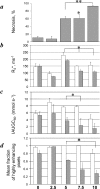Correlation of MRI biomarkers with tumor necrosis in Hras5 tumor xenograft in athymic rats
- PMID: 17534443
- PMCID: PMC1877977
- DOI: 10.1593/neo.07145
Correlation of MRI biomarkers with tumor necrosis in Hras5 tumor xenograft in athymic rats
Abstract
Magnetic resonance imaging (MRI) can measure the effects of therapies targeting the tumor vasculature and has demonstrated that vascular-damaging agents (VDA) induce acute vascular shutdown in tumors in human and animal models. However, at subtherapeutic doses, blood flow may recover before the induction of significant levels of necrosis. We present the relationship between changes in MRI biomarkers and tumor necrosis. Multiple MRI measurements were taken at 4.7 T in athymic rats (n = 24) bearing 1.94 +/- 0.2-cm3 subcutaneous Hras5 tumors (ATCC 41000) before and 24 hours after clinically relevant doses of the VDA, ZD6126 (0-10 mg/kg, i.v.). We measured effective transverse relaxation rate (R2*), initial area under the gadolinium concentration-time curve (IAUGC(60/150)), equivalent enhancing fractions (EHF(60/150)), time constant (K(trans)), proportion of hypoperfused voxels as estimated from fit failures in K(trans) analysis, and signal intensity (SI) in T2-weighted MRI (T(2)W). ZD6126 treatment induced > 90% dose-dependent tumor necrosis at 10 mg/kg; correspondingly, SI changes were evident from T2W MRI. Although R2* did not correlate, other MRI biomarkers significantly correlated with necrosis at doses of > or = 5 mg/kg ZD6126. These data on Hras5 tumors suggest that the quantification of hypoperfused voxels might provide a useful biomarker of tumor necrosis.
Figures





References
-
- Folkman J. Tumor angiogenesis. Adv Cancer Res. 1985;43:175–203. - PubMed
-
- Folkman J. Angiogenesis in cancer, vascular, rheumatoid and other disease. Nat Med. 1995;1:27–31. - PubMed
-
- Fox SB, Gasparini G, Harris AL. Angiogenesis: pathological, prognostic, and growth-factor pathways and their link to trial design and anticancer drugs. Lancet Oncol. 2001;2:278–289. - PubMed
-
- Thorpe PE. Vascular targeting agents as cancer therapeutics. Clin Cancer Res. 2004;10:415–427. - PubMed
-
- Davis PD, Dougherty GJ, Blakey DC, Galbraith SM, Tozer GM, Holder AL, Naylor MA, Nolan J, Stratford MR, Chaplin DJ, et al. ZD6126: a novel vascular-targeting agent that causes selective destruction of tumor vasculature. Cancer Res. 2002;62:7247–7253. - PubMed
MeSH terms
Substances
LinkOut - more resources
Full Text Sources
Medical
